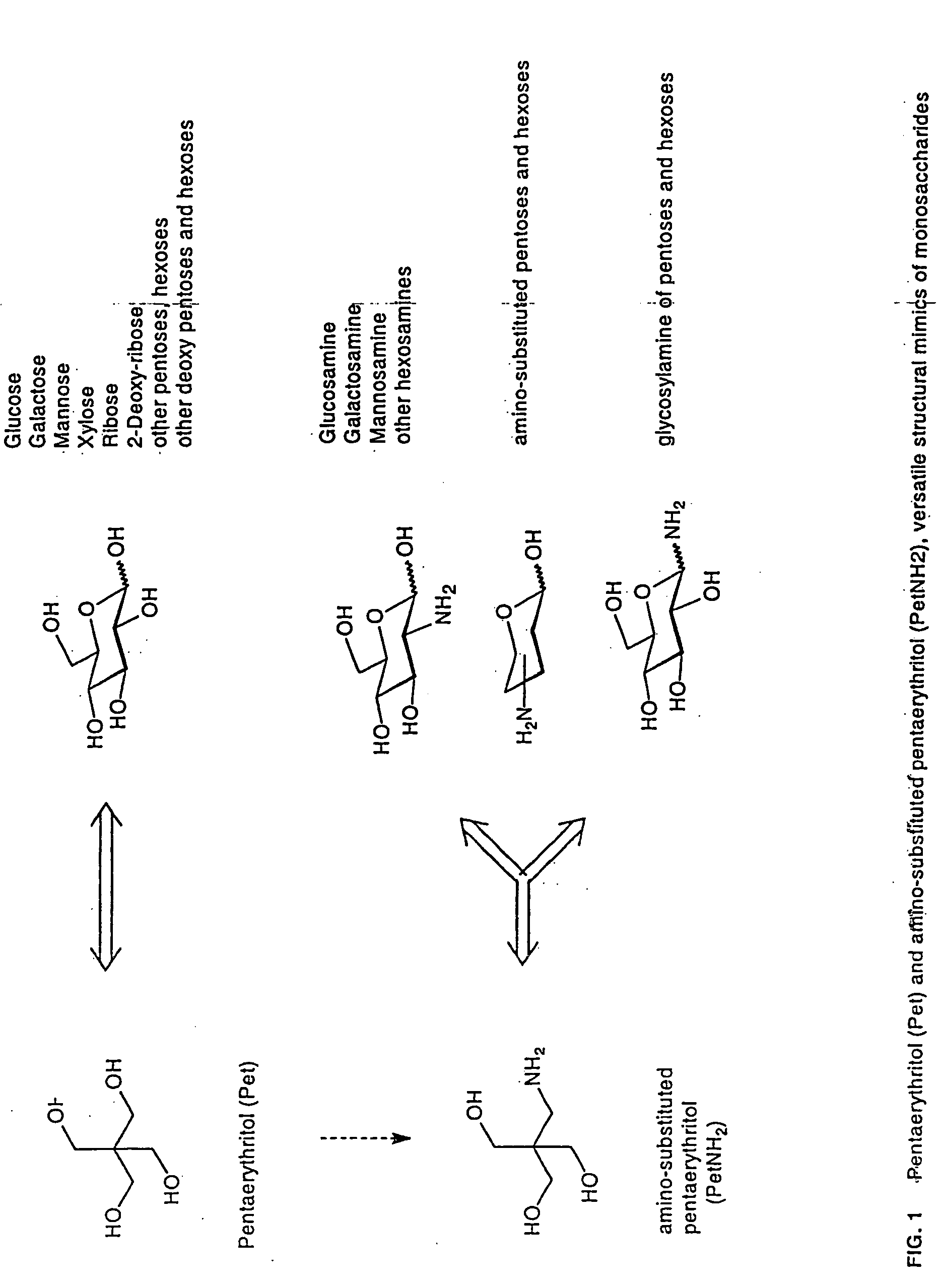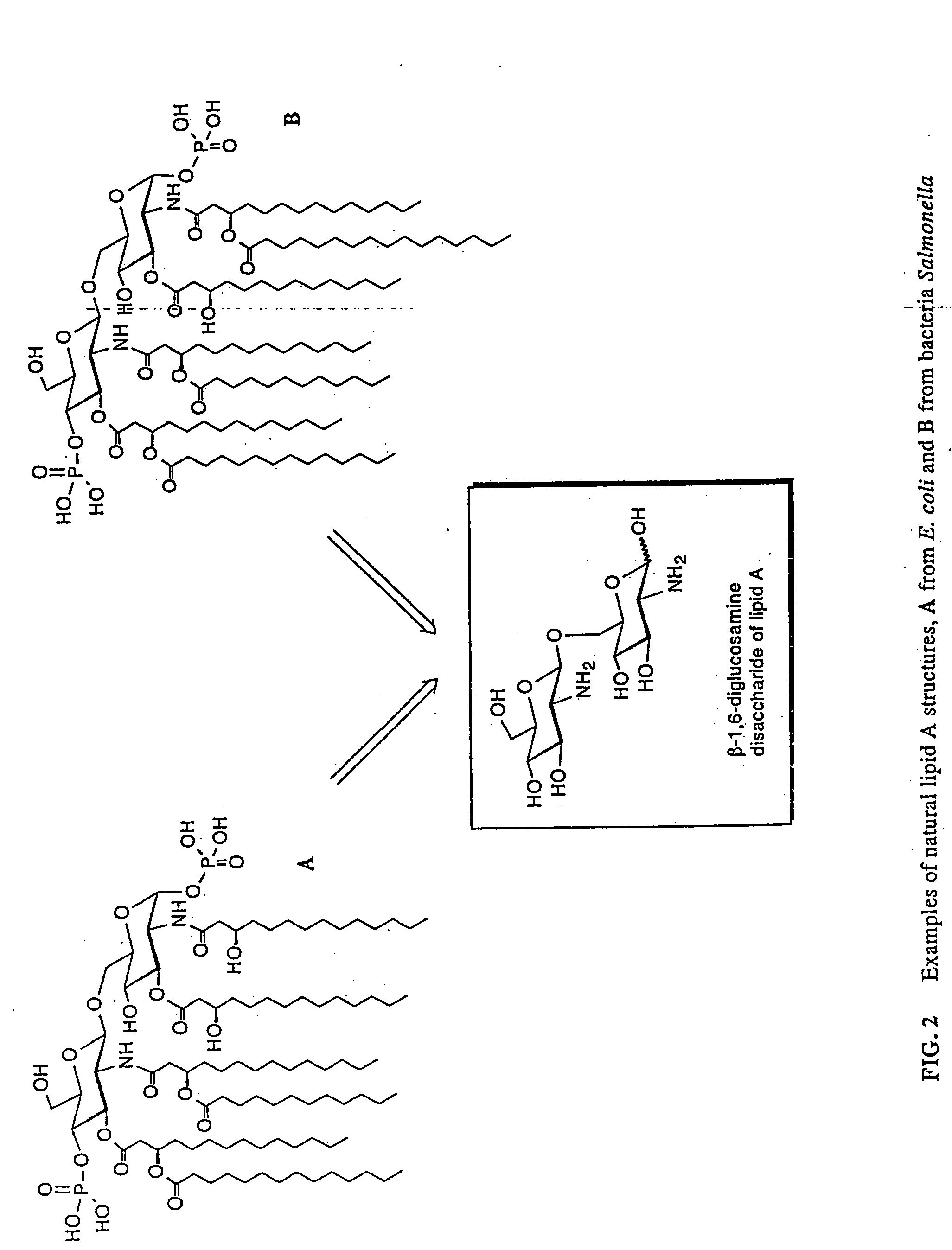Lipid a and other carbohydrate ligand analogs
a technology of carbohydrate ligand and analog, which is applied in the field of lipid analog, can solve the problems of pyrogenic and potentially lethal, heat-stable endotoxin of gram-negative bacteria, and inability to replace sugar units, etc., and achieves the effects of improving vaccine efficacy, strong immune response, and improving innate immunity
- Summary
- Abstract
- Description
- Claims
- Application Information
AI Technical Summary
Benefits of technology
Problems solved by technology
Method used
Image
Examples
example 1
Preparation of Compound 8
[0381] Compound 6 (312 mg, 0.65 mmol), 7 (200 mg, 0.44 mmol), DCC (136 mg, 0.66 mmol) and DMAP (27 mg, 0.22 mmol) were dissolved in dry dichloromethane (5 ml). The mixture was stirred at room temperature for 4 h. The solid was filtered off and washed with ethyl acetate (5 ml). The filtrate was concentrated and the residue was purified by flash chromatography (hexane:ethyl acetate, 8:1) to give 8 (398 mg, 98%). TLC: Rf=0.69 (hexane:ethyl acetate, 3:1). [a]D22=+32.0 (c 0.5, chloroform). 1H NMR (300 MHz, CDCl3): d 0.90 (t, J=6.5 Hz, 6 H, 2 CH3) , 1.25 (m, 38 H, 19 CH2), 1.52 (m, 4 H, 2 CH2), 2.16 (t, J=7.5 Hz, 2 H, CH2), 2.50 (dd, J=16.0, 6.0 Hz, 1 H, CHH), 2.63 (dd, J=16.0, 6.0 Hz, 1 H, CHH), 3.71 (dd, J=9.5, 9.5 Hz, 1 H, H-4), 3.78 (dd, J=10.0, 10.0 Hz, 1 H, H-6a), 3.94 (m, 1 H, H-5), 3.98-4.08 (m, 2 H, H-2, CHHCH═CH2), 4.21 (m, 1 H, CHHCH═CH2), 4.29 (dd, J=10.0, 5.0 Hz, 1 H, H-6b), 4.69, 4.76 (2 d, J=12.0 Hz, each 1 H, Troc-CH2), 4.94 (d, J=3.6 Hz, 1 H, H-1...
example 2
Preparation of Compound 9
[0382] To a solution of 8 (1.45 g, 1.60 mmol) in dry THF (20 ml) was added molecular sieves (4 A, 3.0 g). The mixture was stirred at room temperature under nitrogen for 20 min. Sodium cyanoborohydride (1.0 g, 15.96 mmol) was added and the mixture was cooled to 0° C. HCl (g) / Et2O solution was added drop wise slowly till no gas was evolved. The mixture was then poured into saturated sodium bicarbonate solution (50 ml) and extracted with dichloromethane (100 ml×3). Combined organic layers were washed with saturated sodium chloride solution (20 ml) and dried with sodium sulfate, and concentrated. The residue was purified by flash silica gel chromatography (initially with hexane:ethyl acetate, 5:1 and then 4:1) to give 9 (1.23 g, 85%). TLC: Rf=0.20 (hexane:ethyl acetate, 4:1). [a]D20=+47.5 (c 1.0, CHCl3). 1H NMR (300 MHz, CDCl3): d 0.88 (t, J=6.5 Hz, 6 H, 2 CH3), 1.25 (br s, 38 H, 19 CH2), 1.50 (m, 4 H, 2 CH2), 2.28 (t, J=7.5 Hz, 2 H, CH2), 2.48 (dd, J=14.0, 4.0...
example 3
Preparation of Compound 10
[0383] To compound 9 (1.20 g, 1.30 mmol) in dry dichloromethane (20 ml) were added 1H-tetrazole (273 mg, 3.90 mmol) and dibenzyl diisopropylphosphoramidite (900 mg, 0.875 ml, 2.61 mmol). The mixture was stirred at room temperature for 30 min and then cooled to 0° C. m-Chloroperbenzoic acid (m-CPBA, 1.63 g, 55%, 5.22 mmol) was added and the mixture was stirred for 30 min at 0° C. The mixture was then poured into 10% sodium hydrogen sulfite (40 ml) and extracted with dichloromethane (40 ml×3). The organic layer was washed with saturated sodium bicarbonate solution (20 ml), dried with sodium sulfate and concentrated. The residue was purified by repeated flash chromatography (initially hexane:ethyl acetate, 4:1 and then 3:1). TLC: Rf=0.31 (hexane:ethyl acetate, 3:1) to give 10 (1.33 g, 86%). [a]D20=+35.0 (c 1.0, CHCl3). 1H NMR (300 MHz, CDCl3): d 0.88 (t, J=6.5 Hz, 6 H, 2 CH3), 1.24 (br s, 38 H, 19 CH2), 1.50 (m, 4 H, 2 CH2), 2.17 (t, J=7.0 Hz, 2 H, CH2), 2.41...
PUM
| Property | Measurement | Unit |
|---|---|---|
| Time | aaaaa | aaaaa |
| Density | aaaaa | aaaaa |
| Density | aaaaa | aaaaa |
Abstract
Description
Claims
Application Information
 Login to View More
Login to View More - R&D
- Intellectual Property
- Life Sciences
- Materials
- Tech Scout
- Unparalleled Data Quality
- Higher Quality Content
- 60% Fewer Hallucinations
Browse by: Latest US Patents, China's latest patents, Technical Efficacy Thesaurus, Application Domain, Technology Topic, Popular Technical Reports.
© 2025 PatSnap. All rights reserved.Legal|Privacy policy|Modern Slavery Act Transparency Statement|Sitemap|About US| Contact US: help@patsnap.com



